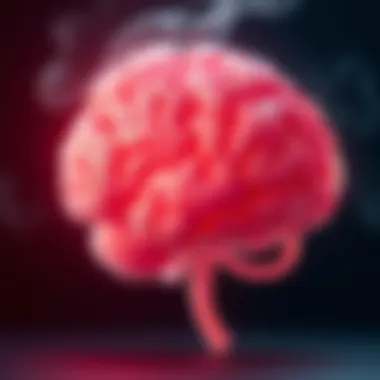Understanding Physical Symptoms When Quitting Smoking


Intro
Quitting smoking is often likened to climbing a mountain; it’s a steep, challenging journey that many have tried to tackle. During this trek, individuals often experience a range of physical symptoms resulting from nicotine withdrawal. The body's intricate web of systems reacts to the absence of a substance it has grown accustomed to, leading to an array of conceivable discomforts. Understanding these symptoms is paramount for anyone seeking to become smoke-free.
The reality is, this journey isn’t just about fighting cravings or battling urges; it’s also a significant transformation on both a physical and mental level. As you stand at the base of this metaphorical mountain, it’s crucial to arm yourself with knowledge about what lies ahead. By recognizing the physical manifestations that accompany quitting, you can better navigate the path and tackle the challenges head-on.
In this article, we will unpack the various physical symptoms that arise during the cessation process. We’ll dive into how the body responds to nicotine absence, the changes that unfold, and practical strategies for managing these symptoms effectively. This way, as you embark on this odyssey toward better health, you will be equipped with the tools and insights you need to face the difficulties with confidence.
Prelims to Quitting Smoking
Understanding the process of quitting smoking is crucial for those embarking on this significant life change. It isn't merely about putting down a cigarette; it encompasses a myriad of physiological and psychological adjustments that one's body will undergo. By grasping these changes, individuals can better anticipate the challenges they may face and develop effective coping strategies. This knowledge equips them to approach their quit journey with a sense of preparedness and resilience.
The Importance of Understanding Withdrawal
Withdrawal from nicotine is a formidable hurdle in the quitting process. Each person may experience this differently, but recognizing the symptoms is pivotal. First off, these symptoms can kick in quite swiftly after the last smoke, often within hours, and can last for weeks or even months. If one understands that irritability, cravings, anxiety, and physical discomfort are all part of this mechanism, it becomes less of a personal failing and more a natural response of the body freeing itself from addiction.
Understanding withdrawal not only helps in managing expectations but also aids individuals in cultivating compassion for themselves during this transition. With this mindset, they can take steps to mitigate these symptoms, whether through activities to distract, nutritional adjustments, or mindfulness practices.
Overview of Nicotine Addiction
To fully appreciate the journey of quitting smoking, it’s essential to recognize the depth of nicotine addiction. Nicotine, a powerful chemical found in tobacco, acts on the brain’s reward system, leading to changes in mood and cognitive function. When someone smokes, they experience a rapid increase in dopamine levels, which creates a pleasurable sensation. This reward system can quickly reinforce the smoking behavior, making it extremely difficult to quit.
Research shows that nicotine is more addictive than alcohol and many drugs, which explains why many people relapse when trying to quit. It’s not just about the habit of smoking; it’s also about combating the chemical dependency. People often focus on the physical aspects, forgetting the psychological components, such as habit and environment, which also contribute to the cycle of addiction.
Understanding these elements aids individuals in identifying triggering situations and devising strategies for long-term cessation. This holistic comprehension underscores the importance of viewing nicotine addiction as a multifaceted challenge, one that encompasses physical dependence, psychological ties, and even social factors. Thus, as smokers pause to consider their journey ahead, they empower themselves with the knowledge needed for a smoke-free life.
Physiological Response to Quitting Smoking
Understanding the physiological response to quitting smoking is crucial for anyone endeavoring to kick the habit. It’s important not just from a physical standpoint, but also for the mental fortitude one must muster during this challenging time. When individuals put down their cigarettes, their bodies undergo a myriad of changes, often leading to uncomfortable symptoms. Comprehending these responses lays a foundation for effective coping mechanisms and helps to mitigate fear or anxiety about what to expect during the quitting process.
Immediate Effects of Nicotine Withdrawal
When someone decides to quit smoking, they often experience immediate effects of nicotine withdrawal. These effects can start within hours after the last cigarette. Here are some of the commonly felt symptoms:
- Cravings: A relentless urge to smoke can hit like a freight train. The body, used to a regular influx of nicotine, screams for that familiar fix.
- Irritability: Mood swings and irritability become frequent companions. The sudden drop in nicotine starts to affect neurotransmitters in the brain, leading to feelings of frustration and anxiety.
- Increased appetite: Many quitting smokers report feeling hungrier than ever. The body starts recalibrating, and some may reach for snacks as a distraction from cravings.
- Difficulty concentrating: The fog that settles in may feel thick. Many experience fuzziness in their thoughts that can make even basic tasks seem daunting.
"The journey to quitting isn't just physical; it’s a battle within the mind as much as it is against a physical substance."
These initial withdrawals can feel like climbing a mountain with no summit in sight. However, they are short-lived compared to the long-term benefits of quitting.
Long-term Bodily Adjustments
After navigating the immediate effects, the body slowly begins the process of long-term bodily adjustments. This adjustment period can stretch from weeks to months and varies widely among individuals. Some notable changes include:
- Respiratory Improvements: The lungs begin to clear, and oxygen flow gets better. Many ex-smokers report increased lung capacity and improved overall breathing after just a few months.
- Vascular Health: Blood circulation improves gradually. This leads to reduced blood pressure and a lower risk of heart disease over time.
- Enhanced Immune System: The immune system gets a reboot. Without the constant onslaught of toxins, the body can start repairing itself, reducing the risk of infections.
- Changes in Weight: While some may gain weight due to increased appetite, others find that with healthy diet choices, they lose the extra pounds. Adjusting food habits and engaging in regular physical activity can mitigate this concern significantly.
As these changes take hold, the emotional battle can be just as intense as the physical withdrawal symptoms. Understanding these bodily adjustments provides a sense of hope and patience, allowing individuals to realize that persistence pays off. The journey is arduous, but the payoff is a healthier, smoke-free existence.
Common Physical Symptoms Experienced


Understanding the common physical symptoms associated with quitting smoking is crucial for anyone embarking on this journey. These symptoms are not just temporary discomforts; they signal the body’s effort to heal and adjust after a long period of nicotine dependence. Recognizing these symptoms early on can help individuals prepare mentally and physically for what lies ahead, making the quitting process somewhat more manageable.
Respiratory Changes
One of the first noticeable changes after quitting smoking involves the respiratory system. Many ex-smokers report a sense of increased breathability, almost as if they are rediscovering fresh air after years of clouded lungs. Tobacco smoke has a detrimental effect on lung function, and when one stops smoking, the lungs begin to reclaim their natural ability to function properly. Expect some temporary coughing as the body works to clear out accumulated toxins and mucus. This process can feel uncomfortable, but it’s a sign that your respiratory system is repairing itself. Over time, individuals may notice improvements in their lung capacity, along with a decrease in coughing spells and overall respiratory illnesses.
Digestive Issues
Quitting smoking can also lead to a variety of digestive troubles. When nicotine intake halts, it's not unusual for people to experience changes in their appetite and digestion. Some report increased cravings for certain foods, especially sweets, which can be attributed to the body’s attempt to soothe nicotine withdrawal with other forms of pleasure. This might lead to overeating, gaining more weight than desired, or some digestive discomfort like bloating or constipation. Staying hydrated and eating a balanced diet can alleviate some of these symptoms. Prioritizing fiber-rich foods may also help keep the digestive system running smoothly.
Sleep Disturbances
Many people overlook how quitting smoking can impact sleep patterns. The body, now devoid of nicotine, undergoes significant changes, which might lead to insomnia or restless nights. A person previously accustomed to using cigarettes as a means of relaxation could find it difficult to wind down without them. The cravings can manifest at night, causing interruptions in sleep. For some, sleep disturbances may be temporary, resolving as the body adjusts to its new state. Establishing a nighttime routine and creating a calm sleep environment can help improve sleep quality during this sensitive time.
Skin Reactions
Interestingly, quitting smoking can lead to various skin reactions. Some might notice breakouts or dry skin shortly after they quit. This can be attributed to changes in circulation and the body’s adjustment to a smoke-free lifestyle. As blood flow improves, skin may start to heal but could initially experience some flare-ups. After the body adapts, individuals often report clearer and healthier skin, offering a visible reminder of their decision to quit. Regular moisturizing and a proper skincare routine can significantly help in mitigating early skin issues during this phase.
The Psychology of Physical Symptoms
When individuals decide to quit smoking, they often fixate on the physical symptoms that accompany nicotine withdrawal. However, the psychology behind these symptoms plays a pivotal role in the entire process. Understanding this psychological aspect can profoundly influence how a person navigates their journey toward a smoke-free life. Knowing the psychological triggers can help in managing stress, cravings, and emotional responses.
The interplay between mind and body is significant during this time. It’s not just about the cravings for nicotine or the withdrawal headaches. Emotional ups and downs can exacerbate physical sensations, causing a cycle of discomfort. Therefore, comprehending how the mind impacts physical symptoms is crucial for developing effective coping strategies.
Mind-Body Connection
The relationship between psychological states and physical health is well-documented. When quitting smoking, the mind influences how one perceives withdrawal symptoms. For example, anxiety or heightened stress can amplify physical discomfort — making a headache feel worse or turning a slight nausea into a more intense feeling.
Researchers have noted the connection between thoughts and physical symptoms linked to smoking cessation. When an individual feels tense or anxious, the body reacts. Muscles may tighten, breath becomes shallow, and heart rate may increase, manifesting in various physical symptoms. Recognizing this mind-body connection allows individuals to address both psychological and physical sides of their withdrawal experience. For instance:
- Engaging in deep-breathing exercises can help soothe anxiety and promote relaxation.
- Practicing meditation or mindfulness techniques can cultivate a positive mindset, reducing the perception of discomfort.
"The mind is the greatest weapon in combating physical symptoms; harnessing it shifts the balance toward healing and recovery."
Additionally, maintaining an awareness of the mind-body link encourages individuals to stay proactive about their mental health. Keeping a journal can also help; noting thoughts and feelings provides clarity and may uncover patterns that can be transformed into actionable coping mechanisms.
The Role of Stress
Stress is a formidable adversary for those attempting to quit smoking. It often acts as a trigger for cravings, making the cessation process feel like an uphill battle. The physiological responses to stress can mimic or worsen withdrawal symptoms. Increased cortisol levels lead to heightened anxiety, agitation, or restlessness, which can confuse one into thinking that these sensations stem solely from nicotine withdrawal.
Identifying stress triggers is essential. Some common culprits include:
- Work pressures: Heavy workloads or conflicts with colleagues.
- Personal issues: Relationships or financial concerns can weigh heavily on one's mind.
- Environmental factors: For instance, being around other smokers may evoke memories of smoking, triggering cravings.
Once these triggers are recognized, individuals can formulate a plan to handle them more effectively. This might involve implementing simple stress management techniques, such as:
- Time management: Organizing tasks to avoid last-minute scrambling.
- Physical activity: Regular exercise, like walking or yoga, can help alleviate stress and improve mood.
- Social support: Engaging in conversations with friends or family about one’s struggles can provide emotional relief.
Effect of Physical Symptoms on Mental Health


Understanding the interconnectedness of physical symptoms and mental health during the quitting process is crucial. When someone decides to quit smoking, the body undergoes significant changes due to the absence of nicotine. These physical alterations often manifest as discomfort, which can lead to heightened emotional challenges such as anxiety and depression. Recognizing these effects not only provides insight into the quitting journey but also helps individuals proactively manage their mental health alongside their physical experiences.
Anxiety and Cravings
Nicotine withdrawal can stir up a cocktail of emotions that significantly heighten anxiety levels. For many, the act of smoking has been a coping strategy for handling stress. Without that release, feelings of unease and irritability can emerge. It's worth noting that cravings for cigarettes are not just about the chemical dependency but also reflect the psychological patterns formed over time.
- Physical responses: Symptoms like restlessness, rapid heartbeat, and sweating often accompany cravings, making the experience intense and uncomfortable.
- Mental hurdles: This anxiety can create a vicious cycle where the desire to smoke intensifies due to stress, making the journey toward recovery feel more daunting.
The key to navigating these feelings lies in developing strategies to cope with anxiety. Techniques like deep breathing, structured physical exercise, or engaging in new hobbies can redirect focus and reduce stress. Mindfulness practices are also beneficial; grounding oneself in the present can create a buffer against the waves of cravings.
"Anxiety can feel like a storm on the horizon, but learning to navigate through it is possible."
Depression Symptoms
Depression often lurks in the shadows during the quitting process, primarily influenced by the body's physiological reactions to nicotine withdrawal. Those who previously relied on smoking as a source of comfort may face a significant emotional void. Symptoms of depression can range from mild sadness to debilitating feelings that interfere with daily life.
- Changes in mood: A decrease in dopamine production, often disrupted by the sudden cessation of nicotine, can lead to feelings of sadness or lack of interest in activities once enjoyed.
- Social withdrawal: As depressive symptoms take hold, individuals may isolate themselves, further exacerbating feelings of loneliness and hopelessness.
Addressing these emotions requires a layered approach. Talking openly about feelings with trusted friends, family, or mental health professionals can provide necessary support. It’s equally vital to remain engaged with social activities or groups, even if the urge to retreat appears strong.
By recognizing the potential toll of physical symptoms on mental health, one can take actionable steps toward recovery. This not only fosters a deeper understanding of personal well-being but also enhances the likelihood of successfully navigating through the quitting process.
Strategies for Coping with Physical Symptoms
Quitting smoking is no small feat; it's akin to steering a ship through turbulent waters. Those who decide to tackle this transition often find themselves facing a myriad of physical symptoms caused by nicotine withdrawal. Understanding and implementing effective coping strategies can drastically improve this challenging experience. These strategies serve as lifelines, providing effective ways to manage symptoms while promoting mental and physical well-being.
Physical Activity and Its Benefits
One of the most dynamic ways to combat the physical symptoms of quitting smoking is through regular physical activity. Exercise can help in multiple ways:
- Mood Enhancement: When you engage in physical activities, your body releases endorphins, often dubbed as 'feel-good hormones'. This can help alleviate feelings of anxiety and depression that may arise during nicotine withdrawal.
- Physical Distraction: Keeping busy with exercise can redirect your mind away from cravings. Instead of fixating on that urge to smoke, you’re focused on your next set of push-ups or your morning jog.
- Restoring Lung Health: Over time, your lung function improves as you quit smoking. Regular, gentle exercises like walking or swimming stimulate better lung capacity.
Furthermore, the feeling of accomplishment after completing a workout can boost confidence, reminding individuals that they are making positive changes in their lives.
Nutrition and Hydration Considerations
Maintaining a balanced diet and staying well-hydrated plays a crucial role in easing withdrawal symptoms. Incorporating nutritious foods can enhance your body’s healing process:
- Fruits and Vegetables: Foods like oranges and leafy greens not only provide essential vitamins but also can help boost your immune system as your body repairs itself post-smoking.
- Protein-Rich Foods: Lean meats, beans, and nuts can help stabilize blood sugar levels, reducing mood swings and cravings.
- Hydration: Drinking sufficient water can aid in flushing out toxins accumulated in the body from smoking. It's also essential for combatting dry mouth, a common occurrence when quitting.
It's worth noting that cravings for sweets are common when quitting. Instead of grabbing a candy bar, opting for healthier alternatives like fruit can provide satisfaction without the guilt.
Mindfulness Techniques
Amidst the whirlwind of physical symptoms, practicing mindfulness can be greatly beneficial. This involves paying attention to one’s thoughts and feelings without judgment. Here are some techniques:
- Deep Breathing Exercises: Simple yet powerful, focusing on deep and slow breaths can help manage stress and anxiety levels. Spending just a few minutes a day can create a feeling of calmness.
- Meditation: Setting aside time for meditation can improve your overall sense of well-being. It encourages self-reflection and helps center your emotions — particularly useful when cravings hit.
- Journaling: Writing out thoughts and feelings can serve as an outlet. Documenting your journey not only provides clarity but also allows you to track progress and remind yourself of your motivations for quitting.
Mindfulness can transform distress into distance, enabling you to witness cravings as waves that come and go rather than an uncontrollable force.


Equipped with these strategies, individuals can navigate the rocky terrain of quitting smoking with a better toolkit. A combination of physical activity, healthy nutrition, and mindfulness techniques can enhance both physical and mental resilience, paving the way toward a smoke-free future.
Seeking Professional Help
Quitting smoking is a challenging journey, and it’s often said that two heads are better than one. When individuals make the decision to stop smoking, they frequently underestimate the emotional and physical toll it takes on their entire being. Seeking professional help is not just beneficial; it can prove to be a vital part of the quitting process. By leveraging expert guidance and support, many find the strength and resources needed to navigate withdrawal effectively.
Counseling and Behavioral Therapy
One significant tool in the toolbox of quitting smoking is counseling and behavioral therapy. This method provides an opportunity for individuals to explore the personal reasons behind their smoking habits in a safe, understanding environment. Through counseling, individuals can gain valuable insights about their triggers and develop coping strategies tailored to their specific situations.
Behavioral therapy often employs techniques such as cognitive-behavioral therapy (CBT), which focuses on changing negative thought patterns related to smoking. This can help tackle the deeply ingrained habits associated with nicotine addiction. Furthermore, group counseling sessions open the door to shared experiences. Hearing stories from others in similar situations can be remarkably validating and encouraging. People can learn new strategies and discover that they are not battling this difficult venture alone.
Benefits of Counseling:
- Personalized insight into smoking triggers
- Development of coping strategies
- Support from trained professionals and peers
- Exploration of underlying psychological issues
Support Groups
Support groups play a crucial role in the quitting process as well. These gatherings provide a community setting where individuals can share struggles, victories, and advice. The act of talking about their experiences with others who truly understand fosters a sense of belonging and accountability. It’s often in these supportive circles that people realize their feelings are not isolated.
Moreover, support groups can vary in structure, ranging from formalized programs led by professionals to informal gatherings organized by ex-smokers. Regardless of the format, what holds value is the commitment from every participant to assist one another in sobriety from nicotine. Members often exchange practical tips, such as breathing exercises to handle cravings or engaging in new habits to replace smoking.
For many, the encouragement felt in these groups is tangible, which can be a strong driving force to remain smoke-free. Even in moments of weakness, knowing a network is there to uplift can make all the difference.
Key Points about Support Groups:
- Establishes a sense of community
- Provides accountability
- Shares practical strategies for coping
- Encourages open expression of feelings and concerns
"Being around others who have been through the same struggles can ignite the desire to stay committed and succeed."
Closure and Reflection
The journey of quitting smoking is not just a simple transition; it's a profound transformation that touches many aspects of an individual's life. This concluding section aims to encapsulate the essence of the physical symptoms experienced during cessation, emphasizing how these challenges can serve as pivotal learning moments in the path toward health and well-being.
Understanding the manifestations of nicotine withdrawal is crucial for anyone contemplating or experiencing the quit-smoking journey. It's not merely about resisting the urge to smoke; instead, it's about embracing the physical and psychological changes that our bodies undergo. Each symptom—be it cough, irritability, or fatigue—is a reminder of the body unwrapping itself from the grips of nicotine.
Long-term Outlook on Health
In the long haul, the health benefits of quitting smoking outweigh the temporary discomforts experienced during withdrawal. While immediate symptoms may feel like a mountain to climb, the view from the summit—better lung function, reduced risk of heart disease, and improved overall quality of life—makes the struggle worth it.
- Improved Cardiovascular Health: Studies suggest that cardiovascular health starts to show improvement just a year after quitting.
- Enhanced Respiratory Function: Within months of quitting, lung function can dramatically improve, reducing chronic cough and respiratory infections.
- Decreased Cancer Risk: Over time, the risk of developing various cancers can be lowered significantly, offering a promising trajectory for long-term health.
A proactive approach to health post-quitting can help manage any lingering physical symptoms. This can include regular check-ups, physical activity, and a nutritious diet—all crucial elements for establishing a smoke-free lifestyle that promotes enhanced well-being.
Embracing a Smoke-free Life
Embracing a smoke-free life is as much about adopting new habits and perspectives as it is about letting go of old ones. It's an opportunity to rebuild one's identity, one where health and vitality take precedence over nicotine cravings.
- Lifestyle Changes: Many find success in incorporating various activities, such as exercise, mindfulness, or artistic pursuits, to redirect focus and energy away from smoking.
- Community and Support: Engaging with support networks—from community groups to online forums—can provide invaluable encouragement and insight, helping individuals not feel isolated in their journey.
The road to becoming smoke-free is paved with challenges, yet it is also rich in rewards. By viewing the quitting process as a holistic experience—recognizing both the struggles and triumphs—individuals can cultivate resilience and a deeper appreciation for their health.
"Every day without smoking is a small victory, a step closer to a healthier self."
Ultimately, the commitment to a smoke-free life is a declaration of self-love and dedication to long-term health. As the smoke clears, it's essential to reflect on the journey, celebrate the victories, and remain mindful of the profound change taking place within.















